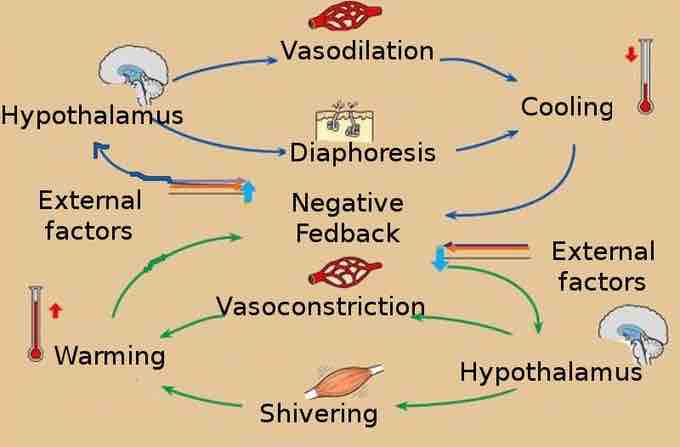Concept of Homeostasis
Homeostasis regulates an organism's internal environment and maintains a stable, constant condition of properties like temperature and pH. Homeostasis can be influenced by either internal or external conditions and is maintained by many different mechanisms. All homeostatic control mechanisms have at least three interdependent components for the variable being regulated:
- A sensor or receptor detects changes in the internal or external environment. An example is peripheral chemoreceptors, which detect changes in blood pH.
- The integrating center or control center receives information from the sensors and initiates the response to maintain homeostasis. The most important example is the hypothalamus, a region of the brain that controls everything from body temperature to heart rate, blood pressure, satiety (fullness), and circadian rhythms (sleep and wake cycles).
- An effector is any organ or tissue that receives information from the integrating center and acts to bring about the changes needed to maintain homeostasis. One example is the kidney, which retains water if blood pressure is too low.
The sensors, integrating center, and effectors are the basic components of every homeostatic response. Positive and negative feedback are more complicated mechanisms that enable these three basic components to maintain homeostasis for more complex physiological processes.
Positive Feedback
Positive feedback is a mechanism in which an output is enhanced in order to maintain homeostasis. Positive feedback mechanisms are designed to accelerate or enhance the output created by a stimulus that has already been activated. Positive feedback mechanisms are designed to push levels out of normal ranges. To achieve this, a series of events initiates a cascading process that builds to increase the effect of the stimulus. This process can be beneficial but is rarely used because it may become uncontrollable. A positive feedback example is blood platelet accumulation and aggregation, which in turn causes blood clotting in response to an injury of the blood vessels.
Negative Feedback
Negative feedback mechanisms reduce output or activity to return an organ or system to its normal range of functioning. Regulation of blood pressure is an example of negative feedback. Blood vessels have sensors called baroreceptors that detect if blood pressure is too high or too low and send a signal to the hypothalamus. The hypothalamus then sends a message to the heart, blood vessels, and kidneys, which act as effectors in blood pressure regulation. If blood pressure is too high, the heart rate decreases as the blood vessels increase in diameter (vasodilation), while the kidneys retain less water. These changes would cause the blood pressure to return to its normal range. The process reverses when blood pressure decreases, causing blood vessels to constrict and the kidney to increase water retention.

Negative Feedback Loop
The hypothalamus secretes corticotropin-releasing hormone (CRH), which directs the anterior pituitary gland to secrete adrenocorticotropic hormone (ACTH). In turn, ACTH directs the adrenal cortex to secrete glucocorticoids, such as cortisol. Glucocorticoids not only perform their respective functions throughout the body but also prevent further stimulating secretions of both the hypothalamus and the pituitary gland
Temperature control is another negative feedback mechanism. Nerve cells relay information about body temperature to the hypothalamus. The hypothalamus then signals several effectors to return the body temperature to 37 degrees Celsius (the set point). The effectors may signal the sweat glands to cool the skin and stimulate vasodilation so the body can give off more heat.
If body temperature is below the set point, muscles shiver to generate heat and the constriction of the blood vessels helps the body retain heat. This example is very complex because the hypothalamus can change the body's temperature set point, such as raising it during a fever to help fight an infection. Both internal and external events can induce negative feedback mechanisms.

Homeostatic Control
This image illustrates the feedback mechanisms of homeostatic controls.